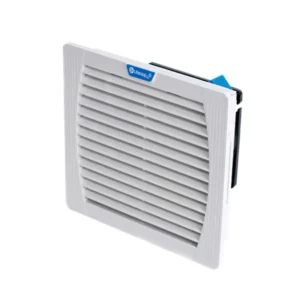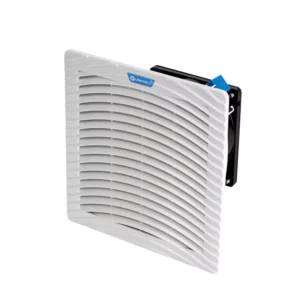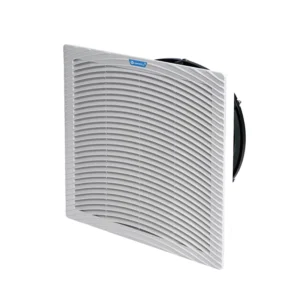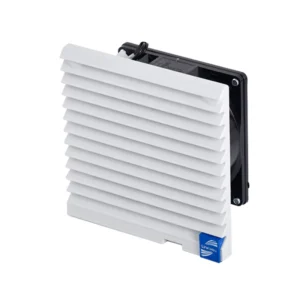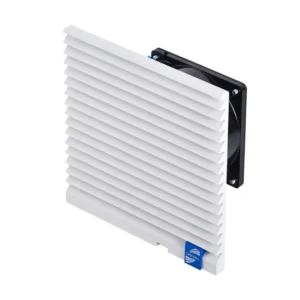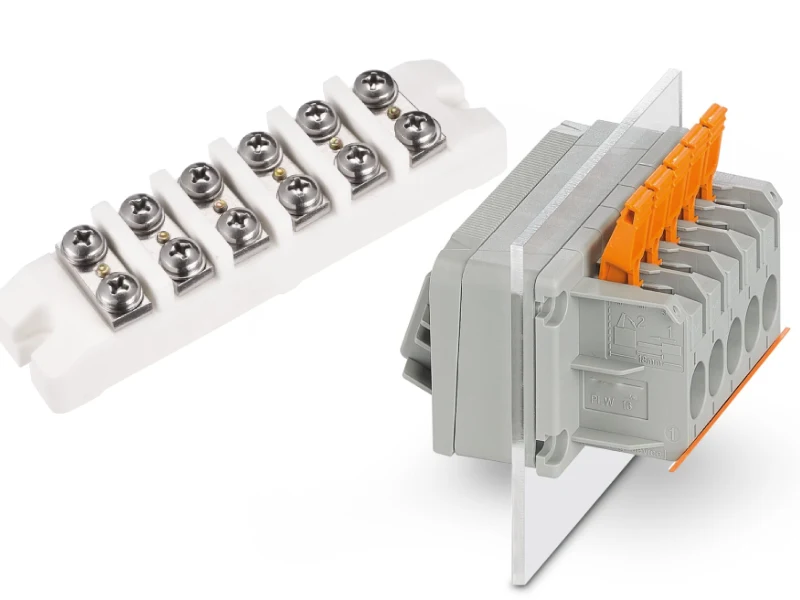From intricate electronics to massive industrial machinery, heat is a constant challenge. This is where cooling fans become indispensable. These seemingly simple devices play a critical role in thermal management, ensuring optimal performance and extending the lifespan of countless systems.
This ultimate guide will explore everything you need to know about cooling fans. We’ll delve into their fundamental principles, various types, and crucial factors to consider when selecting and maintaining them for any application, from personal computers to large-scale industrial operations.
What is a Cooling Fan?
Recommended Cooling Fan
-
FF202 Cooling fan and filter
-
FF109 IP54/55 Electric Cabinet Ventilation Cooling Fan with Filter
-
FK5523 Cooling fan and filter
-
FK5527 Cabinet filter cooling fan electrical control cabinet
-
LK3243 Industrial Electrical Cabinet Cooling Fan
-
LK6621 Rittal cabinet cooling fan and filter
-
LK6623 Axial fan, cabinet cooling fan
-
LK6627 Cooling Fan and Filter
A cooling fan is an electromechanical device designed to facilitate heat dissipation by moving air. It operates by using rotating blades, powered by a motor, to generate a current of air. This airflow then serves to draw hot air away from heat-generating components or areas, replacing it with cooler air from the surrounding environment.
Cooling fans are crucial for maintaining optimal operating temperatures in a wide range of applications, from preventing electronic equipment from overheating (like in computers and industrial control panels) to enhancing comfort in residential and commercial spaces by improving air circulation.
Cooling Fan Structure
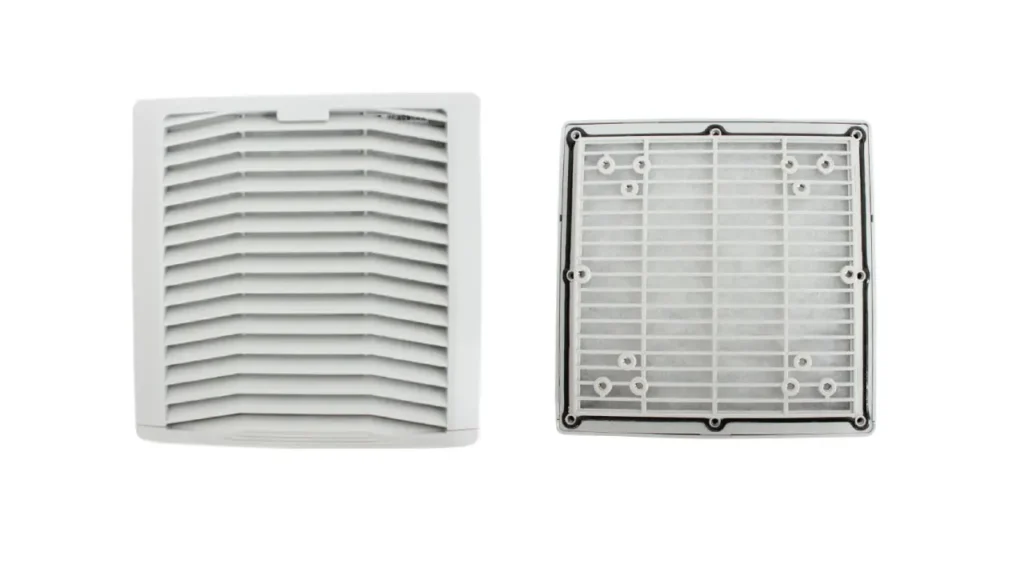
Cooling fans, while appearing simple, are composed of several key structural elements that work in concert to generate airflow and facilitate heat transfer. The overall design aims to efficiently move air while being compact and durable enough for their intended application, whether in a confined electronic enclosure or a larger ventilation system.
The core components ensure the fan’s mechanical operation and air movement capabilities, forming the complete assembly.
Here are the primary components of a cooling fan’s structure:
Fan Blades/Impeller:
- These are the rotating elements responsible for moving air. Blades are designed with specific aerodynamic profiles (e.g., axial, centrifugal) to optimize airflow volume and pressure for different applications.
- They are typically made from lightweight, rigid materials like plastic (ABS, polycarbonate), aluminum, or steel, chosen for their balance of strength and weight.
Motor:
- The motor provides the rotational power to spin the fan blades. Common types include AC motors (shaded pole, capacitor-start) for larger fans, and DC brushless motors for smaller, more efficient electronic cooling applications.
- It is housed within the fan’s frame and connected to the blades, often via a central shaft.
Frame/Housing:
- This is the outer structure that encases the motor and blades, providing mounting points and often acting as a protective shroud. Frames can be square, round, or custom-shaped depending on the application.
- Materials range from plastic (e.g., PBT, ABS) for lighter-duty fans to metal (e.g., aluminum alloy, steel) for more robust industrial or high-temperature applications.
Bearings:
- Bearings support the rotating shaft of the motor, reducing friction and enabling smooth, quiet operation. Common types include sleeve bearings (cost-effective, quieter) and ball bearings (longer lifespan, higher performance, can be noisier).
- The choice of bearing significantly impacts the fan’s lifespan, noise level, and operational stability.
Grille/Guard (Optional but common):
- Many fans, especially those in exposed locations, feature a protective grille or finger guard on the intake and/or exhaust side.
- This prevents foreign objects from entering the fan and protects users from accidental contact with the rotating blades, enhancing safety.
Terminal Block/Wiring:
- This is where the electrical connection is made to power the fan’s motor. It typically consists of a terminal block or leads for wiring, ensuring a secure and standardized power input.
- The wiring connects the power source to the motor windings, allowing the fan to operate.
How does a Cooling Fan Work?
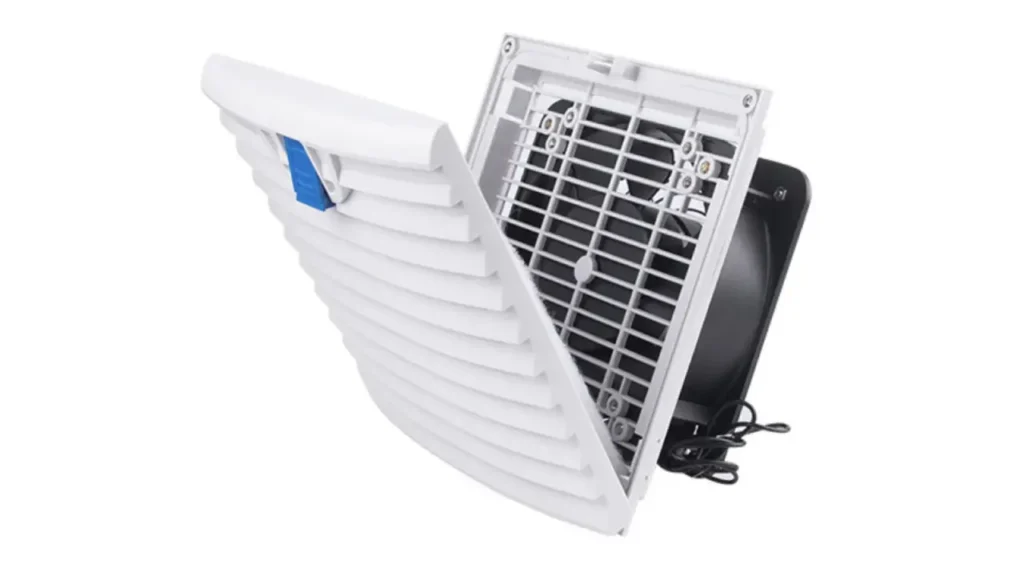
Cooling fans operate on a fundamental principle of thermodynamics: convection, the transfer of heat through the movement of fluids (in this case, air). The core mechanism involves a motor rotating a set of blades, which are aerodynamically designed to create airflow. This directed airflow serves multiple purposes in heat management:
- Heat Removal: The fan draws in cooler ambient air and pushes it across heat-generating surfaces (like circuit boards, heat sinks, or machinery components). As the cooler air passes over these hot surfaces, it absorbs thermal energy.
- Forced Convection: By actively moving air, the fan significantly increases the rate of heat transfer compared to natural convection (where heat simply rises). This “forced” movement rapidly carries away the heated air, preventing it from lingering and re-heating the components.
- Replacement with Cooler Air: As the hot air is pushed away, it’s continuously replaced by fresh, cooler air from the surroundings, maintaining a temperature gradient that encourages further heat transfer from the hot object to the air.
- Dispersal of Heat: The fan disperses the heated air into a larger volume, allowing the heat to dissipate more effectively into the ambient environment, preventing localized heat buildup.
Essentially, a cooling fan acts as a miniature air pump, constantly circulating air to remove heat and maintain a stable, lower operating temperature for sensitive equipment or enclosed spaces.
Cooling Fan Types
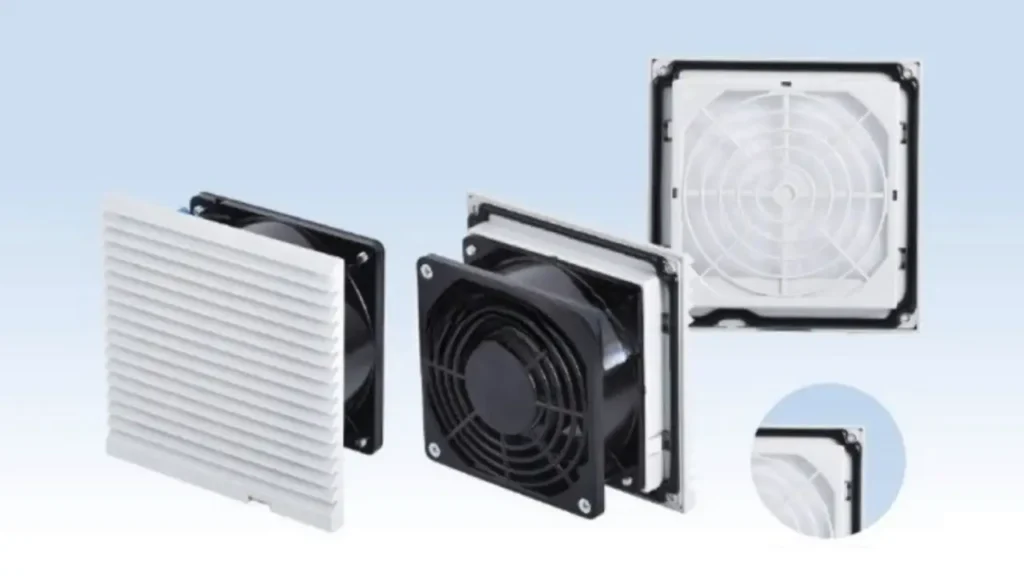
Cooling fans come in various designs, each optimized for specific applications and airflow requirements. The choice of fan type significantly impacts its performance, noise level, and suitability for different environments.
Here are the main types of cooling fans:
- Axial Fans: These are the most common type, moving air parallel to the fan’s axis of rotation. They are highly efficient at moving large volumes of air at relatively low static pressure. You’ll find them in computers, exhaust fans, and general ventilation systems.
- Centrifugal (Blower) Fans: These fans draw air in through the center and expel it perpendicularly to the fan’s axis, creating a higher static pressure than axial fans. They are excellent for applications requiring air movement through ducts or against resistance, such as HVAC systems, industrial blowers, and some electronics cooling where pinpoint airflow is needed.
- Mixed Flow Fans: As the name suggests, these fans combine characteristics of both axial and centrifugal fans. They offer a balance of good airflow and moderate static pressure, making them versatile for applications where both volume and pressure are important, like in-line duct fans.
- Cross-Flow Fans (Tangential Fans): These fans have a long, cylindrical impeller that moves air along its entire length. They produce a wide, even flow of air at low static pressure, making them suitable for applications like cooling large surfaces evenly, such as in laser printers or some electronics cabinets.
- Blower Wheels/Squirrel Cage Fans: Often a component within a larger system, these are a type of centrifugal fan where the blades are arranged in a “squirrel cage” fashion. They are commonly found in residential furnaces, air handlers, and some industrial drying applications, designed for moving air through ducts.
Cooling Fan Uses
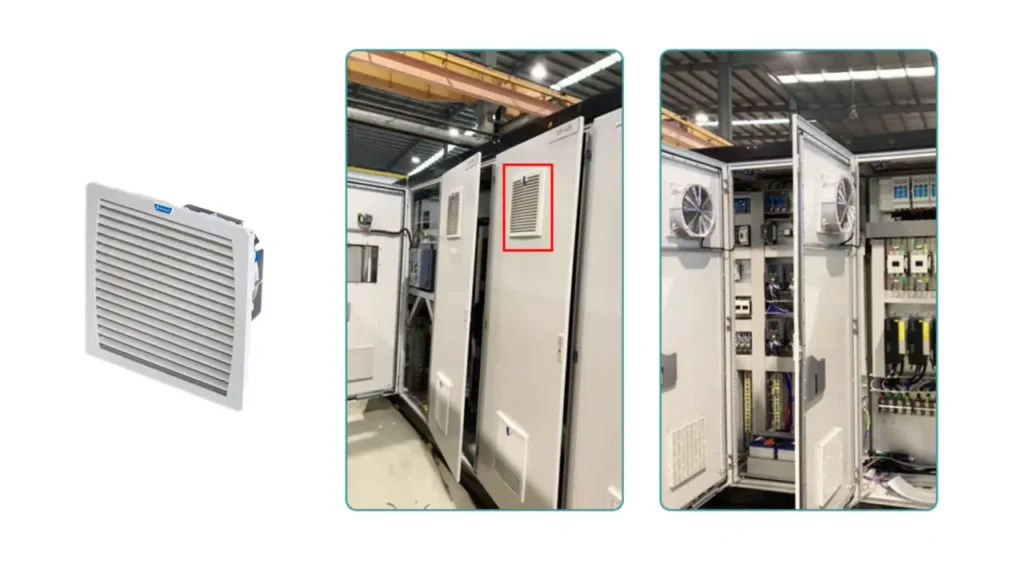
Cooling fans are integral components in countless systems, serving to manage heat and ensure optimal operating conditions. Their applications span across diverse industries and environments, playing a critical role in preventing thermal damage, enhancing performance, and extending the lifespan of equipment.
Here are key applications of cooling fans:
- Electronic Enclosures and Control Cabinets: Crucial for industrial automation, electrical switchgear, and data centers, cooling fans ventilate enclosures and control cabinets, dissipating heat generated by internal components like PLCs, drives, and power supplies to prevent overheating and maintain stable operation.
- Computer and IT Hardware: Found in virtually all computers, servers, and networking equipment, cooling fans move air over CPUs, GPUs, and other heat-generating components to maintain safe operating temperatures and prevent performance throttling or system crashes.
- Industrial Machinery and Equipment: From manufacturing lines to heavy machinery, cooling fans are used to cool motors, bearings, hydraulic systems, and other components that generate significant heat during operation, ensuring reliability and preventing premature wear.
- Automotive Systems: Essential for engine cooling, HVAC systems within the cabin, and cooling of various electronic modules, fans in vehicles prevent overheating and ensure comfortable conditions for occupants.
- Residential and Commercial HVAC: Beyond just electronics, larger cooling fans are fundamental to air conditioning units, furnaces, and ventilation systems, circulating air to distribute conditioned air and remove stale air, contributing to overall comfort and air quality.
Cooling Fan Maintenance
Effective maintenance of cooling fans is crucial for ensuring their optimal performance, longevity, and continued effectiveness in thermal management. Regular upkeep prevents dust buildup, reduces operational noise, and minimizes the risk of overheating in the systems they are designed to cool. Neglecting maintenance can lead to reduced airflow, increased energy consumption, and premature fan failure, ultimately jeopardizing the components or environments they protect.
Here are key aspects of cooling fan maintenance:
- Regular Cleaning: Dust and debris accumulate on fan blades and grilles, impeding airflow. Use compressed air, a soft brush, or a vacuum to gently remove buildup, ensuring unrestricted air movement.
- Lubrication (if applicable): Some older or specific fan types with sleeve bearings may require occasional lubrication. Apply a few drops of appropriate fan oil to the bearing points to reduce friction and noise, following manufacturer guidelines.
- Blade Inspection: Periodically check fan blades for any signs of damage, cracks, or warping. Damaged blades can cause imbalance, increase vibration and noise, and reduce air-moving efficiency, requiring replacement.
- Mounting Security: Ensure the fan is securely mounted and that all screws or fasteners are tight. Loose mounting can lead to excessive vibration, noise, and potential damage to both the fan and its enclosure.
- Power Connection Check: Verify that the power cables are securely connected and free from fraying or damage. Loose or damaged connections can cause intermittent operation or complete fan failure, posing a safety risk.
- Bearing Noise Monitoring: Listen for unusual noises, such as grinding, squealing, or rattling, which often indicate worn-out bearings. Addressing bearing issues promptly can prevent catastrophic fan failure and costly repairs.
- Airflow Obstruction Check: Confirm that there are no external obstructions blocking the fan’s intake or exhaust vents. Clear pathways are essential for efficient air circulation and effective heat dissipation, so remove any blockages.
How to Choose Best Cooling Fans?
Choosing the best cooling fan involves assessing your specific needs to ensure efficient and effective thermal management. The ideal fan will match the application’s requirements for airflow, pressure, size, and operating conditions, preventing overheating without excessive noise or energy consumption.
Here are key factors to consider when selecting a cooling fan:
- Airflow (CFM): This measures the volume of air the fan moves per minute. Match the CFM to the heat load and volume of the space or enclosure to ensure adequate heat dissipation.
- Static Pressure: Consider if the fan needs to push air through restrictive pathways like filters or tight enclosures. Higher static pressure capability is crucial for overcoming resistance and maintaining airflow.
- Fan Size: The physical dimensions of the fan must fit within the available space. Ensure proper clearance for installation and optimal air intake and exhaust pathways.
- Noise Level (dB): For quiet environments like offices or residential spaces, prioritize fans with lower decibel ratings. Industrial applications might tolerate higher noise levels for increased performance.
- Power Consumption: Evaluate the fan’s wattage and voltage requirements. Energy-efficient fans reduce operational costs, especially important for continuously running systems or large installations.
- Bearing Type: Different bearings offer varying lifespans and noise levels. Ball bearings provide longer life and tolerate various orientations, while sleeve bearings are quieter and more cost-effective for specific uses.
- Operating Environment: Account for temperature, humidity, and potential exposure to dust or corrosive elements. Choose fans with appropriate IP ratings or specialized coatings for harsh conditions.
- Mounting Options: Verify the fan’s mounting style (e.g., panel mount, frame mount) and ensure it aligns with your installation requirements for secure and effective placement.
Conclusion
Cooling fans are vital for preventing overheating and ensuring the optimal performance and longevity of electronics, machinery, and even entire spaces. From circulating air in a room to precisely cooling delicate components, understanding their types and functions is crucial for effective thermal management.
Whether you need to dissipate heat from an industrial control cabinet or simply cool down a room, selecting the right cooling fan makes a significant difference. Linkwell Electrics offers a diverse range of high-quality cooling fans designed for various applications, ensuring efficient and reliable thermal solutions.
Investing in appropriate cooling fans from Linkwell Electrics protects your equipment from thermal damage, enhances operational stability, and contributes to a more comfortable and productive environment.

